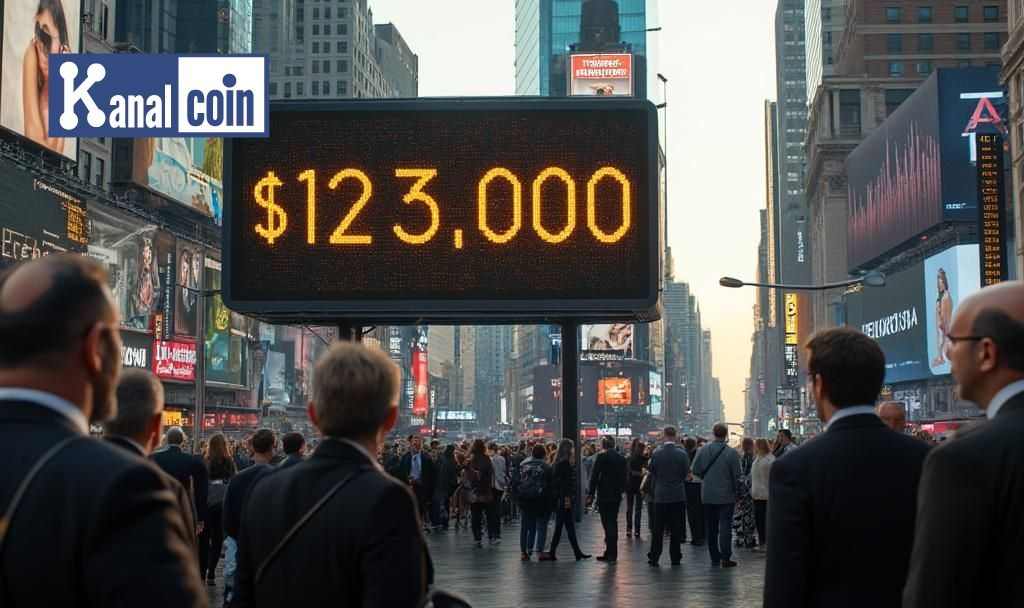Bitcoin reached a new all-time high of $123,000 in July 2025, fueled by significant institutional ETF inflows and U.S. regulatory developments, sparking market speculation on future price corrections.
-
Bitcoin’s record surge driven by $1.18 billion ETF inflows and U.S. Congress’s “Crypto Week” events.
-
Institutional investors like BlackRock and Fidelity lead the market momentum amid cautious Federal Reserve policies.
-
Market experts debate retail participation and potential price corrections despite strong institutional accumulation.
Bitcoin hits $123K in July 2025 amid institutional ETF inflows and U.S. policy shifts. Stay informed with COINOTAG’s expert crypto market analysis.

Bitcoin’s Historic $123K Surge Driven by Institutional ETF Inflows
Bitcoin’s price reached an unprecedented $123,000 in July 2025, marking a significant milestone fueled by institutional ETF inflows totaling $1.18 billion. This surge coincides with the U.S. Congress’s “Crypto Week,” which has heightened market attention and engagement. Institutional players such as BlackRock and Fidelity have been pivotal in driving this momentum, reflecting growing confidence in Bitcoin’s long-term value.
How Do U.S. Policy Shifts Affect Bitcoin’s Market Dynamics?
U.S. regulatory developments, including Federal Reserve monitoring led by Jerome Powell, have introduced cautious optimism among investors. The Fed’s vigilance on financial market stability signals potential policy adjustments, impacting liquidity and market sentiment. These macroeconomic factors contribute to Bitcoin’s volatility, with analysts forecasting possible price corrections despite strong institutional demand.

What Role Does Retail Participation Play in Bitcoin’s Price Movement?
Market commentator Arthur Hayes questions the current retail investor involvement amid Bitcoin’s surge to $123K. While institutional accumulation is evident, retail enthusiasm appears muted, suggesting that the next significant price moves may depend on increased retail buying. Secondary cryptocurrencies like Ethereum have experienced only moderate gains, underscoring Bitcoin’s dominant market position during this rally.
What Are the Potential Market Risks and Opportunities?
Historical patterns from previous all-time highs in 2013 and 2017 show that euphoria often precedes profit-taking corrections. However, current institutional inflows and liquidity adjustments indicate sustained interest and market resilience. On-chain data confirms increased institutional holdings, supporting an optimistic outlook despite short-term volatility. Regulatory updates and liquidity shifts remain key factors to watch.
“Is this it? BTC at $123K and retail’s not even excited yet? Don’t fade. The real move comes when they start buying the top. Watch rates and liquidity. $BTC doesn’t care for old highs when Powell pivots.” — Arthur Hayes, Former CEO, BitMEX, Macro Commentator
Institutional Inflows and Market Resilience: What Does Data Show?
Data reveals that institutional investors continue to accumulate Bitcoin despite market fluctuations. ETF approvals and derivatives launches historically increase volatility but also attract liquidity. This trend suggests Bitcoin’s market resilience is strengthening, supported by expert analysis forecasting sustained growth potential amid evolving macroeconomic conditions.
| Metric | Value | Comparison |
|---|---|---|
| ETF Inflows (July 2025) | $1.18 Billion | Highest since 2021 |
| Bitcoin Price | $123,000 | New All-Time High |
| Retail Investor Activity | Moderate | Lower than Institutional |
Frequently Asked Questions
What factors contributed to Bitcoin’s record price in July 2025?
Bitcoin’s record price of $123,000 was primarily driven by large institutional ETF inflows and positive U.S. regulatory events, which increased market confidence and liquidity.
How does Federal Reserve policy impact Bitcoin’s market?
The Federal Reserve’s cautious approach to financial stability affects liquidity and investor sentiment, influencing Bitcoin’s price volatility and potential corrections.
Key Takeaways
- Bitcoin’s $123K peak: Driven by $1.18 billion in institutional ETF inflows and U.S. regulatory support.
- Retail vs. Institutional: Institutional investors dominate current market activity; retail participation remains moderate.
- Market outlook: Despite volatility, data suggests resilience with potential for sustained growth amid evolving policies.
Conclusion
Bitcoin’s historic surge to $123,000 in July 2025 underscores the growing influence of institutional investors and regulatory developments. While retail participation is cautious, the market shows resilience supported by strong ETF inflows and expert analysis. Monitoring Federal Reserve policies and liquidity trends will be crucial for anticipating future price movements. COINOTAG remains committed to delivering timely, expert insights on evolving crypto market dynamics.
Bitcoin reached a new all-time high of $123,000 in July 2025, sparking debates among traders and analysts about whether this marks a cycle peak and potential price corrections.

This event highlights Bitcoin’s volatility, driven by institutional inflows and U.S. policy shifts, prompting cautious yet bullish market sentiment amid potential obstacles due to macroeconomic conditions.
Bitcoin reached an all-time high of $123,000 in July 2025, drawing substantial institutional attention. This follows significant ETF inflows totaling $1.18 billion and corresponds with U.S. Congress’s “Crypto Week”. These factors have captured widespread market engagement.
Major ETFs, including those by BlackRock and Fidelity, drove this surge. The Federal Reserve, led by Jerome Powell, remains vigilant about financial market impacts, signaling potential policy adjustments to maintain stability. Analysts debate market longevity and project possible corrections.
Arthur Hayes Questions Retail Role in Bitcoin’s Surge
Bitcoin’s surge to $123K spurred debate among traders. Arthur Hayes questions retail involvement, while others eye the Federal Reserve for signals. Meanwhile, secondary tokens like ETH observed only moderate boosts, indicating dominant focus on Bitcoin.
Potential impacts include regulatory updates and shifting liquidity landscapes as major financial players enter. Historical patterns suggest potential profit-taking corrections. On-chain data mirrors increased institutional accumulation, indicating ongoing market confidence amid high volatility.
Institutional Inflows Suggest Bitcoin Market Resilience
Current crypto momentum echoes prior ATH patterns from 2013 and 2017, where euphoria was followed by corrections. Past ETF approvals and derivatives launches often brought higher volatility, influencing current market behaviors and anticipations.
Expert analysis hints at future resilience despite short-term dips. Institutional inflows and liquidity adjustments suggest a sustained interest, supported by data showing increased institutional holdings. As such, potential outcomes remain largely optimistic.
“Is this it? BTC at $123K and retail’s not even excited yet? Don’t fade. The real move comes when they start buying the top. Watch rates and liquidity. $BTC doesn’t care for old highs when Powell pivots.” — Arthur Hayes, Former CEO, BitMEX, Macro Commentator
| Disclaimer: This website provides information only and is not financial advice. Cryptocurrency investments are risky. We do not guarantee accuracy and are not liable for losses. Conduct your own research before investing. |

Author: Redaksi Media
Cryptocurrency Media






